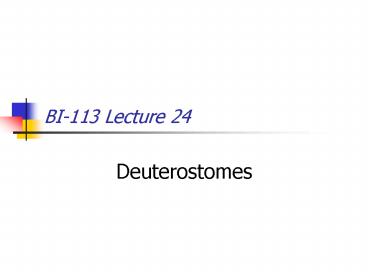BI113 Lecture 24 - PowerPoint PPT Presentation
1 / 24
Title:
BI113 Lecture 24
Description:
Radial, indeterminate cleavage exhibited by early embryo. Coelom forms by enterocoely ... Superficial radial body form (which is secondarily derived from ... – PowerPoint PPT presentation
Number of Views:54
Avg rating:3.0/5.0
Title: BI113 Lecture 24
1
BI-113 Lecture 24
- Deuterostomes
2
The other branch of the tree
- Deuterostomes
- Radial, indeterminate cleavage exhibited by early
embryo - Coelom forms by enterocoely
- Blastopore forms the anus
3
Star light . . . Star bright, but . . .
- Phylum Echinodermata
- Seastars, brittle stars, sea urchins, sand
dollars, and sea cucumbers - 7,000 species
- Marine
- Sessile or slow-moving creatures
- Superficial radial body form (which is
secondarily derived from bilateral morphology) - Body plan is in multiples of 5
4
. . . dont call me Starfish
- Endoskeleton of calcareous plates with thin layer
of skin over the top - The skin has dermal gills, which serve as
respiratory structures - Water vascular system
- Series of paired bulbs (ampullae) with ventral
extensions - tube feet - Madreporite
- Water sieve on dorsal surface that serves as
incurrent pore for network of tubes - Ring canal and radial canals extend into arms of
seastars
5
Sea star anatomy
6
Water vascular system
7
Reproduction in echinoderms
8
Echinoderm diversity
9
Chordates
10
Phylum Chordata
- the Chordates
- 50,000 species
- Chordate characteristics
- These are all seen at some time during the life
cycle - Many may only be seen in larval stages of some of
the lower chordate groups
11
Chordate characters
- Notochord
- Cartilaginous rod for body support
- Dorsal, hollow nerve cord
- Brain and spinal cord with fluid-filled space
- CNS formed from embryonic tissue layer
- Neuroectoderm
- Induced to form by the underlying notochord
12
Chordate characters (cont.)
- Pharyngeal gill slits
- Primitively, the pharyngeal slits serve as
filter-feeding structure - Later modified as gas exchange structures (gills)
- Then as other structures
- Eustachian tube, parathyroid and thymus glands
- Post-anal tail
- Muscular tail that extends beyond the anus
- Used for swimming in many species
13
Chordate characteristics
14
In addition, chordates exhibit . . .
- Strong cephalization
- Bilateral symmetry
- An internal support system
- Endoskeleton allows for continued, uninterrupted
growth (as opposed to the situation in arthropods
that must go through the molting process to
replace the exoskeleton)
15
Four major chordate groups
- Subphylum Hemichordata
- Subphylum Urochordata
- Subphylum Cephalochordata
- Subphylum Vertebrata
16
Subphylum Hemichordata
- the Acorn worms
- 75 species
- Burrowing, marine lower chordate
- Filter feeders
17
Chordate phylogeny
18
Subphylum Urochordata
- the Tunicates or sea squirts
- 2,500 species
- Sessile as adults
- With reduced chordate characters
- Pharyngeal basket serves as filter-feeding
structure - Motile as larvae
19
Sea squirt
20
Urochordata
tadpole larva
21
Subphylum Cephalochordata
- the Lancelets
- Amphioxus - Branchiostoma
- 25 species of marine, sediment-dwelling filter
feeders - This group is especially important because they
seem to represent an evolutionary connection to
the jawless vertebrates
22
Cephalochordates
23
Amphioxus
24
Deuterostome phylogeny

